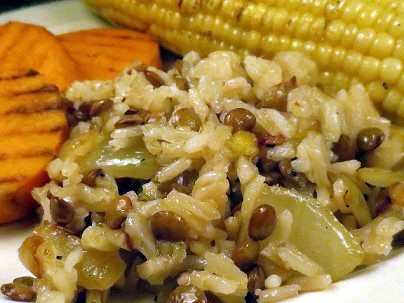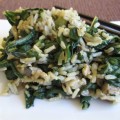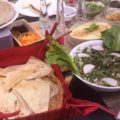
I first encountered this dish while teaching 3rd grade at the American Community School of Beirut back in ’98. While the sun set over the Mediterranean and waves crashed upon the rocky shore beneath the sea wall, I was enjoying a light snack of pita bread and hummis at a bistro on the Corniche. In Lebanon, every city or town that faces the Mediterranean has a Corniche. The Corniche is the road that parallels the water and its name is yet another vestige of Lebanon’s French colonial past when all such roads were known by the French term, “Route à Corniche.”
The Mujadarra was a delightful surprise. The onions and garlic had been caramelized in olive oil and the rich earthy flavor permeated the steamed white rice. The cooked lentils added some contrasting texture, giving the pilaf a pleasant crunch. Although I was not yet a vegetarian while living in Beirut, this simple one dish vegan meal became one of my favorites which I subsequently learned how to cook in my faculty apartment.
The first time I made this meal, the fragrant aroma of garlic and onions frying in extra virgin olive oil brought a couple of hungry Lebanese colleagues running to my apartment. Since hospitality is a cornerstone of the Lebanese culture, I invited these neighbors to dine with me. One of the teachers returned to her apartment for a dish of warak inhab – grape leaves stuffed with tomatoes, chick peas, chopped parsley, onions, and rice. A recipe for this may be found at Mama’s Lebanese Kitchen, http://www.mamaslebanesekitchen.com/vegetarian/grape-leaves-recipe/ . The other teacher brought a bowl of tabouli salad which is made with cracked bulgar wheat, parsley, tomatoes, and a garlic mint dressing. Having seen the bounty that was now offered, I produced some pita bread from my tiny refrigerator which one of my Lebanese colleagues heated in his microwave.
The meal was (unintentionally) completely vegan. As I found during the year I spent in Beirut, the Lebanese do not eat nearly as many animal products as Americans do. Even though the majority of the population is not vegan, they have an abundance of vegan friendly meals that include such dishes as:
- Bamia Bil Zait: Okra fried in olive oil with garlic, tomatoes and coriander
- Batata Harra: Potatoes cooked with olive oil, garlic red peppers, spices and green chile
- Falafel: Mixture of ground chick peas, broad beans, garlic, onions and spices
- Lentil Soup
- Kabees: Selection of Lebanese pickles (cucumber, turnip, chile)
- Moujaddara Bil Zait: Lentils, crushed wheat, onions and spices cooked in olive oil, topped with caramelized onions and almonds
- Moussakaat Batinjan: Fried aubergines cooked with chick peas, onions, tomatoes, garlic and spices
If you live in an area where there’s a local Lebanese restaurant, you might consider dining there if you’re looking for a vegan friendly dining establishment.
I have included a recipe for Mujadarra below.
Regards,
David William Chin
Author of The Unintentional Vegan Cookbook
http://unintentionalvegan.com
Mujadarra
Preparation time: 30 minutes
Yield: 3 cups, 5 oz.
Ingredients:
2 cups steamed white rice
3 oz. brown or green lentils, boiled & drained
10 oz. diced onion
2 oz. extra virgin olive oil
4-5 cloves of minced garlic
1/4th tsp. salt
1/8th tsp. freshly ground black pepper
Tools needed:
Chef’s knife’s knife
Cutting board
Food Scale (or measuring cup)
Frying pan
Spatula
Procedure:
- Cook the onion and garlic over very low heat in the olive oil for 17-20 minutes or until the onion has turned a rich golden brown.
- Stir the steamed white rice and cooked drained lentils into the cooked onions.
- Season the mixture with salt and pepper.
- Taste the pilaf and add more salt and pepper as needed.
Optional Ingredients:
Some Lebanese add ground coriander and cumin to their pilaf. I personally think that this distracts from the simplicity of this meal, but if you want to do this, add 1/4 tsp. ground coriander and 1/2 tsp. of ground cumin after the onions are nearly golden brown.
For protein, consider topping the Mujadarra with your favorite vegan soy cheese. I like topping mine with vegan Pepper Jack. If you do this while the pilaf is still hot, the soy cheese will soften. You can also zap this dish in the microwave.
Suggested Side Dishes:
Mujadarra is often eaten with pita bread and how can one eat pita bread without hummus? I also enjoy eating this dish with an assortment of grilled vegetables. As you can see from my picture, my mixed vegetables included sweet potatoes and corn.
NOTE: If you’re going to grill sweet potatoes and corn, they need to be par-cooked BEFORE you grill them. I typically peel and boil the sweet potatoes for about 7 minutes or until they’re almost fork tender. I also boil the corn prior to putting it on the grill. Grilling the vegetables caramelizes their natural sugars and gives these products a slightly smoky taste. Don’t worry if you don’t have a grill. A grill iron (frying pan with several parallel ridges) will do nicely. Prior to grilling, I would recommend seasoning the vegetables with salt and pepper and lightly brushing them with either olive oil or Canola oil. Since the vegetables are already cooked, you’re really only putting them on the grill for grill marks. Cook the vegetables over high heat and use a metal offset spatula to safely remove them.






1 Comment
Chia (324 comments)
June 12, 2013 at 9:41 pmAll the dishes you noted sound delicious, and this particular dish seems easy. Thanks for sharing.